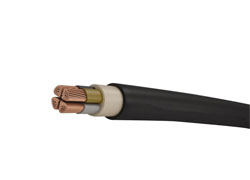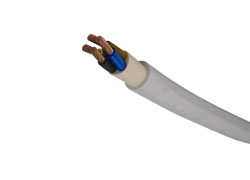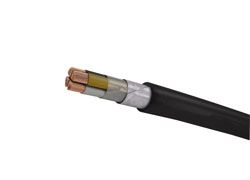18. What is the role of the sheath in the cable?
Answer: The insulation layer will not be in contact with water, air or other objects to prevent the insulation from moisture and the insulation layer from mechanical damage.
19, when using wire cutters should pay attention to what?
A: Before use, be sure to check the insulating handle insulation is intact, use wire cutters can not be cut over the specifications allow the metal wire, and the use of wire cutters instead of a hammer to beat the tool to avoid damage.
20, what is the dielectric strength?
A: In the electric field, when the electric field strength increases to a certain limit, the insulation material will be broken down. This electric field strength that causes insulation breakdown is called the insulation strength.
22. What are the requirements for the mechanical strength of the cable conductor connection point?
A: The mechanical strength of the connection point is generally lower than the tensile strength of the cable conductor itself. For the fixedly installed power cable, the tensile strength of the connection point is not lower than 60% of the tensile strength of the conductor itself.
23. What are the main properties of the insulating material for power cables?
A; should have the following main features:
(1) High breakdown strength;
(2) Low dielectric loss;
(3) High insulation resistance;
(4) Excellent resistance to discharge performance;
(5) Has a certain degree of flexibility and mechanical strength;
(6) Long-term stability of insulation performance.
24. What are the requirements for traction strength when laying cables?
A: For copper core cables, when pulling the head, the allowable traction strength is 70N/cm; for the aluminum core cable, when the head is pulled, the traction strength is allowed to be 40N/cm; if the wire mesh sleeve is used for traction, the lead protection Set cable allowable strength is 10N/cm;
Lead sheathed cable is 40N/cm.
25. What are the regulations for cable protection tubes?
Answer: (1) When the cable needs to wear a protective tube, the inner diameter of the pipe should not be less than 1.5 times the outer diameter of the cable, and the inner diameter of the concrete pipe, clay pipe, asbestos, cement pipe should not be less than 100mm;
(2) The bending radius of the cable tube shall comply with the requirements for the bending radius of the cable to be penetrated;
(3) Each pipe should not have more than three elbows and no more than two right angle bends.
26, how to measure the outer diameter of the cable jacket?
A: At the five points evenly distributed around the jacket circumference, the jacket outer diameter and its average value are measured. The average outer diameter is the outer diameter of the jacket.
27, how to connect different sections of copper cable?
Answer: The copper cables with different cross-sections can be connected by using open weak copper back-ends and connected by soldering. Copper can also be connected by pure copper rods according to different cross-section requirements and connected by crimping.
28. Summarize the process of heat-shrinking a 10KV cross-connect cable to make an indoor terminal.
Answer: (1) Preparation: Check whether the heat shrinkable cable accessories are complete and whether the model matches. After checking and confirming whether there is moisture in the cable, check the cable.
(2) Exclude excess cables and determine the cable length according to site conditions.
(3) Strip the cover.
(4) Weld the ground wire and solder the ground wire to the strip.
(5) Fill the trifurcation and wrap the sealant.
(6) Install a three-core branch sheath, put the sheath into the root, and start contracting from the middle, first to the root and then to the finger.
(7) Strip the copper strip and the outer semi-conductive layer, strip the copper strip with more than 20mm of the three-core branch sleeve, and do not damage the main insulation and remove the clean semi-conductive layer.
(8) Install the stress tube and heat-shrink the joints at the end of the nozzle.
(9) Install the terminal block.
(10) Install the insulation tube.
(11) Install the sealing tube.
(12) Install the phase tube after the nuclear phase.
29. What are the indoor and outdoor prefabricated terminal installation steps?
Answer: (1) Place the cable in position, fix it, clean the surface according to the predetermined position, and remove the sheath with reference to the instruction manual. If special requirements are required, the length of the outer sheath stripping can be adjusted, and the copper strip and the outer sheath can be installed separately. 2 ground lines.
(2) From the outer jacket mouth up to take the required size, remove the excess cable, insert the heat shrinkable three-finger sleeve to the root of the three prongs and heat shrinkage from the middle, the upper part of the fingertips to measure the specified size (35kv to 350 ~ 380mm ). Remove the excess copper tape (retain 20mm), and then keep the semiconductor at a predetermined position, crimping the outlet terminal seal.
30. The application of wire and cable is mainly divided into three categories:
1. Power system
The wire and cable products used in the power system mainly include bare overhead wires, busbars (bus bars), power cables (plastic cables, oil-paper cables (substituted by plastic power cables), rubber sheath cables, overhead insulated cables), and branch cables. (Replace some of the busbars), electromagnetic wires, and electrical equipment.
2, information transmission system
The wire and cable used for information transmission systems mainly include local telephone cables, television cables, electronic cables, radio frequency cables, optical fiber cables, data cables, electromagnetic wires, power communication or other composite cables.
3, mechanical equipment, instrumentation system
Except for the bare overhead wires, this part has applications for almost all other products, but mainly power cables, electromagnetic wires, data cables, instrumentation cables, etc.
31, wire and cable products are mainly divided into five categories:
1, bare wires and bare conductor products
The main features of this type of product are: pure conductive metal, non-insulating and sheathing layers, such as ACSR, copper and aluminum busbars, electric locomotive lines, etc.; the processing technology is mainly pressure processing, such as smelting, rolling, pulling System, stranding/pressing and stranding, etc.; products are mainly used in suburban areas, rural areas, user main lines, switch cabinets, etc.
2, power cable
The main features of this type of product are: Extruding (wrapping) the insulation around the conductor, such as overhead insulated cables, or strands of cores (corresponding to the phase, neutral and ground of the power system), such as over two core overhead insulated cables , Or increase the jacket layer, such as plastic / rubber sheathed wire and cable. The main process technologies include drawing, stranding, insulation extrusion (wrapping), cabling, armoring, sheath extrusion, etc. There are certain differences in the different process combinations of various products.
The products are mainly used in the transmission of electricity, electricity, electricity, electricity, electricity, electricity and electricity in high-voltage transmission lines, with large currents (tens of amps to several thousand amps) and high voltages (220V to 500kV and above).
3, wire and cable for electrical equipment
The main features of this type of product are: variety of specifications, a wide range of applications, the use of voltage in 1kV and below, in the face of special occasions continue to derive new products, such as fire-resistant cables, flame retardant cable, low smoke and halogen-free / low Smoke low-halogen cable, termite prevention, rat-proof cable, oil/cold resistance/temperature/wear resistance cable, medical/agricultural/mine cable, thin-walled wire, etc.
4, communication cables and optical fiber (brief introduction)
With the rapid development of the communications industry over the past two decades, the products have also been developing at an alarming rate. From the simple telephone telegraph cable in the past to the development of thousands of pairs of voice cables, coaxial cables, optical cables, data cables, and even composite communication cables.
The size of such products is usually small and uniform, and the manufacturing precision is high.
(5) Magnet wire (winding wire)
Mainly used for various motors, instruments and meters.
Basic knowledge of wire and cable
Wire and cable derivatives/new products
The derivative/new products of wire and cable are mainly due to the requirements of different applications, different application requirements, and the convenience of equipment and the reduction of equipment costs. New materials, special materials, or changes in product structure, or technological requirements, or different requirements The products of the varieties are combined and produced.
Use different materials such as flame-retardant cables, low-smoke and halogen-free/low-smoke and low-halogen cables, termite-proof cables, mouse-proof cables, oil/cold/heat-resistant cables, etc.;
Change product structure such as: fire-resistant cables;
Improve process requirements such as: medical cables;
Combination products such as: OPGW;
Easy to install and reduce equipment costs such as: prefabricated branch cables.
32. What inspections should be performed after the bus device is completed?
Answer: The following inspections should be conducted:
(1) The processing, preparation and welding of metal components should meet the requirements;
(2) All parts such as bolts, washers, and split pins should be complete and reliable;
(3) The busbar preparation and installation rack should comply with the regulations, and the electrical distance between phases and earth should meet the requirements;
(4) Porcelain pieces, iron pieces and gluing joints shall be complete, and the oil-filled casing shall be free from oil leakage and normal oil level;
(5) The paint is complete, the phase is correct, and the grounding is good.
33. In 35kv and below power cable joints, there are several ways to improve the distribution of the electric field at the break of the jacket (please list five types), and briefly describe its method.
Answer: (1) Swelling flare: The edge of the lead package should be picked up at the cutting point of the lead package and it should be horn-shaped. Its edge should be smooth, round and symmetrical.
(2) Retained package insulation: There is a piece of turn-up insulating paper between the lead-bag cuts and the separation point of the cable core.
(3) Cut off the semiconductive paper: Cut the semiconductive paper below the bell mouth.
(4) Enveloping the stress cone: Tapering the tape with an insulating tape and a conductive metal material artificially expands the shielding layer to improve the electric field distribution.
(5) Equipotential method: For dry-type or cross-linked polyethylene cable heads, a metal band is wrapped around the insulation surface of each core and connected together.
(6) Install the stress control tube: For the 35kv and send the heat shrinkable tube cable head, firstly surround the two layers of semiconductor tape from the direction of the end of the copper core shielding layer through the semiconductor tape to the insulation of the core, and then make the corresponding specification of the stress The tube, sleeved at the end of the copper shield, is heat-shrink molded.
34, cable bracket processing should meet the requirements?
Answer: (1) The steel should be straight, without obvious distortion, the blanking error should be in the range of 5mm, and the cut should have no curling or burrs;
(2) The brackets should be firmly welded without any significant deformation. The vertical distance between the cross braces and the design deviation should not exceed 5 mm;
(3) The metal stent must be treated with anti-corrosion treatment. When it is located in hot and humid areas, salt, fog, and chemically corroded areas, it should be designed for special anti-corrosion treatment.
35. List the cables you are familiar with.
A: Welded E-frames, assembled E-frames, bridged cable racks, cable trays, hook-type brackets, single-wire brackets, etc.
The production cable can be divided into more than 50 varieties and subdivided into 1000 specifications.All products have passed national certification, such as China compulsory certification, bv certification, Nigerian SONCAP certificate, China national industrial certification, etc. China national industrial production license, etc.It also has the ability to produce products that meet international standards, such as iec, ce, rohs, etc.
If you want to buy wires and cables, you can ask the customer service staff and we will get back to you as soon as possible.
-

600-1000V CU XLPE Power Cable
Conductor:Bare Copper Conductor of Class 1/2 (Solid)
Insulation:XLPE Compound
Insulation Color:Red, Blue, Grey, Yellow/Green or as request
-

600-1000V AL XLPE Power Cable
3500 V:Bare Aluminum Conductor of Class 1/2 (Solid)
Insulation:XLPE Compound
Insulation Color:Red, Blue, Grey, Yellow/Green or as request
-

600-1000V Flexible Power Cable
Conductor:Bare Copper Conductor of Class 5 (Flexible)
Insulation:PVC Compound
Insulation Color:Red, Blue, Grey, Yellow/Green or as request
-

600-1000V SWA Armoured Cable
Conductor:Bare Copper Conductor of Class 1/2 (Solid)
Insulation:XLPE Compound
Insulation Color:Red, Blue, Grey, Yellow/Green or as request





